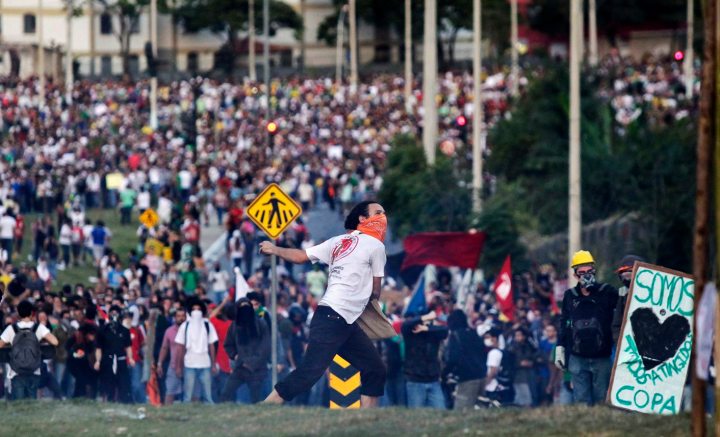Sport
Sport and politics: the unavoidable cocktail

In the last two weeks, on two continents, two very different protests have been taking place. One was at a sporting event; the other was sparked by a sporting event. One has grabbed the attention of the mainstream media, the other has gone largely unreported. What both protests have done, though, is serve as a reminder that sport and politics are an unavoidable mix. BY ANTOINETTE MULLER.
In the last weeks, on opposite ends of the world and sporting spectrum, two very opposite protests have been taking place.
In Brazil, football supporters have been dodging rubber bullets and blocking roads heading into stadiums, all while the Confederations Cup is on the go. Mobs of very angry people have been launching stones at Fifa offices, ripping down Confed Cup placards and burning them. The most loved game in Brazil has become a vehicle for anger, fuelling some of the biggest demonstrations in decades. Civilians are angry over corruption, the dire state of public service, low levels of security, the treatment of those in slums and the money bleeding to Fifa in a bid to make sure the World Cup goes off without a hitch next year.
In England, meanwhile, during the Champions Trophy, hundreds of members of Britain’s Tamil community held up the Sri Lankan team bus after the semi-final between Sri Lanka and India in Cardiff. There were placards held up at almost every other game, too. In Cardiff, during the semi-final, there was a pitch invasion, and while the protest remained largely peaceful, those who invaded the pitch were arrested and could be fined up to 1,000 pounds.
They were protesting against Lankan president Mahinda Rajapaksa’s government over widespread atrocities against civilians and combatants during the 2009 war. According to their leaflets, the protest aims “to raise awareness about the atrocities that were committed by the Sri Lankan government and the ongoing human rights abuses of Tamils in the north-east of the island. Boycotting Sri Lankan cricket is an effective way of applying pressure on the government to allow an independent investigation into its alleged war crimes.”
Two completely different causes, two different sports and two different cities, but one common denominator: wanting to be heard.
Using sport as a platform for raising concerns is nothing new, but in reality it is rather difficult. Sport has for so long been used as a vehicle for cohesion, even when people are miles apart, that it is difficult to pierce the veil of sentimentality. In South Africa in 2010, for example, the delusion of togetherness prevailed, underscored by that kick of Siphiwe Tshabalala’s in the opening game against Mexico.
In some cases, though, even sport-related sentimentality isn’t strong enough to subdue people’s outrage.
Cricket has been used in this way for years: South Africa being suspended by the ICC, for example; Andy Flower and Henry Olonga with their black armbands, and Edison Mukwazi’s death in 2003. Mukwazi died from injuries sustained while in police detention after protesting at a Zimbabwe-Pakistan one-day international in November 2002. He was caught distributing leaflets against the cricket World Cup being held in the country.
The Tamil protesters at Sri Lankan games are becoming a common occurrence. They want a boycott of the national team. They were protesting in 2011, too. In that instance, they floated a red weather balloon above the pavilion. Few took notice, just like few took notice this time around – even when nearly 400 protestors stood just 500 yards from the team dressing room.
At that same semi-final in Cardiff, these protestors managed to get onto the pitch. Six men ran in from all angles of the stadium and brandished flags of Liberation Tigers of Tamil Eelam (LTTE) that had an emblem depicting a tiger jumping through a circle of bullets, with crossed bayonets on a red background. The flags were hidden in their pockets and security had said that the fans had made it into the ground under the guise of being Indian supporters. The LTTE is categorised as a terrorist organisation by 32 countries, including India, but has support amongst some Tamils in Tamil Nadu in India.
When Neville de Silva, Sri Lanka’s deputy high commissioner in London, was asked about the protests, he dismissed them, referring to the “tattered remnants of the LTTE [Liberation Tigers of Tamil Eelam]”.
It’s not in the interests of fair reporting to make a call on what’s right and wrong in this instance. But what is clear is that when 400 people gather and hold up a team bus, a conversation needs to be started.
Two continents, two sporting events, two completely different causes. One has grabbed the headlines, the other has gone largely unnoticed, despite the efforts of protestors.
Politics has a relationship to sport, certainly. And in Sri Lanka, those who serve on the cricket board are determined by government. The ICC have kept silent on that issue for two years now, despite sending a warning that they should free themselves from this kind of meddling. It’s unavoidable that the two will combust.
For an outsider to understand the intricacies of the Tamils of Sri Lanka’s protest is almost impossible. Civil War ended in the country just four years ago. What happened and how those involved were treated has gone largely unreported by mainstream and western media, a fault of no one specifically; rather a function of culture. To at least begin a conversation, therefore, would have been a victory for the protesters.
Critics may feel that sport and politics should be kept separate; that protesters should protest away from the game and leave sport as an escape from the realities of life. That’s an unrealistic expectation, however, given the visibility of high-profile sporting events, which must necessarily attract those seeking a platform. Certainly this doesn’t doesn’t mean that those wanting to be heard are always right. But it does underline their right to be heard. DM
Photo: Demonstrators clash with police in the vicinity of the Mineirao Stadium in Belo Horizonte, June 22, 2013. Demonstrators in Brazil gathered this week to continue the growing protest that is tapping into widespread anger at poor public services, mainly health, education and transport. REUTERS/Alexandre C. Mota




















 Become an Insider
Become an Insider